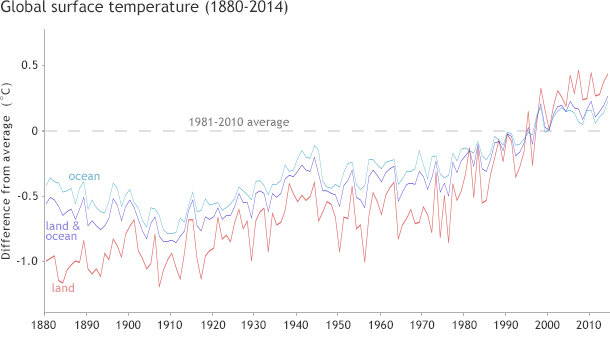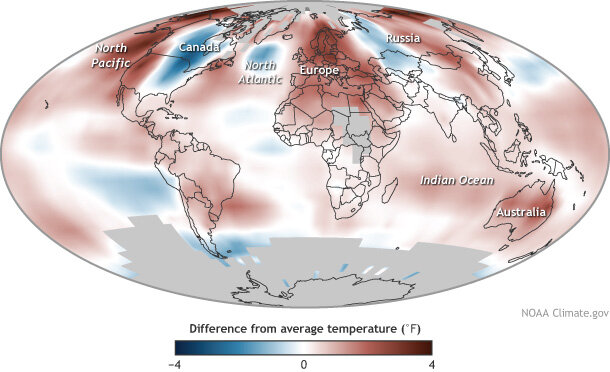2014 State of the Climate: Earth’s Surface Temperature
Why surface temperature matters
Of all the planets in our neighborhood, Earth has a surface temperature that is uniquely friendly to life. That friendliness is the result of a balancing act between incoming sunlight and outgoing thermal energy—the heat radiated back to space by every part of the Earth system, from land to oceans to clouds and, especially, by the gases in the atmosphere. Surface temperature is one of the most direct of several signals that indicate the status of Earth’s heat budget. Earth’s long-term warming trend shows that the balance has changed: the atmosphere absorbs and radiates more heat (thermal infrared energy) than it used to.
Conditions in 2014
Average temperature in 2014 compared to the 1981-2010 average. Adapted from Plate 2.1c in "State of the Climate in 2014." Download editable PDF.
Globally averaged surface temperature for 2014 was 0.27° -0.29° Celsius (0.49°-0.52°F) above the 1981–2010 average. Depending on the small differences among different data sets, 2014 was either the warmest or tied-for-warmest year since records began in the mid-to-late 1800s.
Overall, the globally averaged annual temperature over land was 0.37-0.44° Celsius (0.70° -0.79° F) above the 1981-2010 average, ranking it as the warmest year in some datasets and fourth-warmest in others. Land surfaces over Eurasia and western North America were particularly warm in 2014, and the frequency of warm temperature extremes was above average for all regions apart from North America.
The only land areas with widespread temperatures below the 1981-2010 average were the eastern half of the contiguous United States, central and southern Canada, and parts of central Asia. Eastern North America, including the eastern U.S., was relatively cool for the majority of 2014, with some sharp cold air outbreaks early in the year.
In 2014, the globally averaged sea surface temperature was 0.21-0.27°C (0.34°-0.49°F) above the 1981-2010 average--the highest on record according to all datasets. Even though conditions across the tropical Pacific Ocean were ENSO-neutral to marginal, sea surface temperatures averaged across the larger Pacific basin were much warmer than average in 2014. Every major ocean basin had at least one region with temperatures more than 1°C warmer than average during 2014. Some areas across the Atlantic, South Pacific, and northwestern Pacific Oceans experienced below-average temperatures.
Change over time

Annual departures from average temperature for land areas (pink), ocean areas (blue), and combined (purple) since 1880. Graph adapted from Figure 2.1 in State of the Climate in 2014.
Since the historical climate record began in the 1880s, the average surface temperature had risen by 0.88°C (1.6°F) through 2014, which is a rate of 0.66°C (1.2°F) per century. Globally, 2014 was the warmest year in the historical record—or tied for warmest, depending on the small differences that exist among different datasets. More significantly, 17 of the 18 warmest years on record have occurred in the last 18 years.
The natural variability of climate, including El Niño and La Niña cycles and the warm and cool phases of the Pacific Decadal Oscillation, causes surface temperature to rise and fall from year to year and even decade to decade. This “short-term” variability is overwhelmed, however, by what is happening over longer timescales; from the perspective of a century or longer, all both land and ocean have warmed.
To calculate global average temperature, four independent teams accessed air temperatures from weather stations on land and sea surface temperatures collected by ships and buoys. Each team used their own methods to analyze and merge the land and ocean datasets to estimate annual temperature for the whole globe. Though their methods differ, all four analyses are in close agreement about the long-term increase in global temperature.
References
Sánchez-Lugo, A., P. Berrisford and C. Morice, 2015: Surface Temperature [in “State of the Climate in 2014”]. Bulletin of the American Meteorological Society, 96 (7), S9-S14.
